PORSCHE 911 2009 5.G Information Manual
Manufacturer: PORSCHE, Model Year: 2009, Model line: 911, Model: PORSCHE 911 2009 5.GPages: 59, PDF Size: 5.74 MB
Page 11 of 59
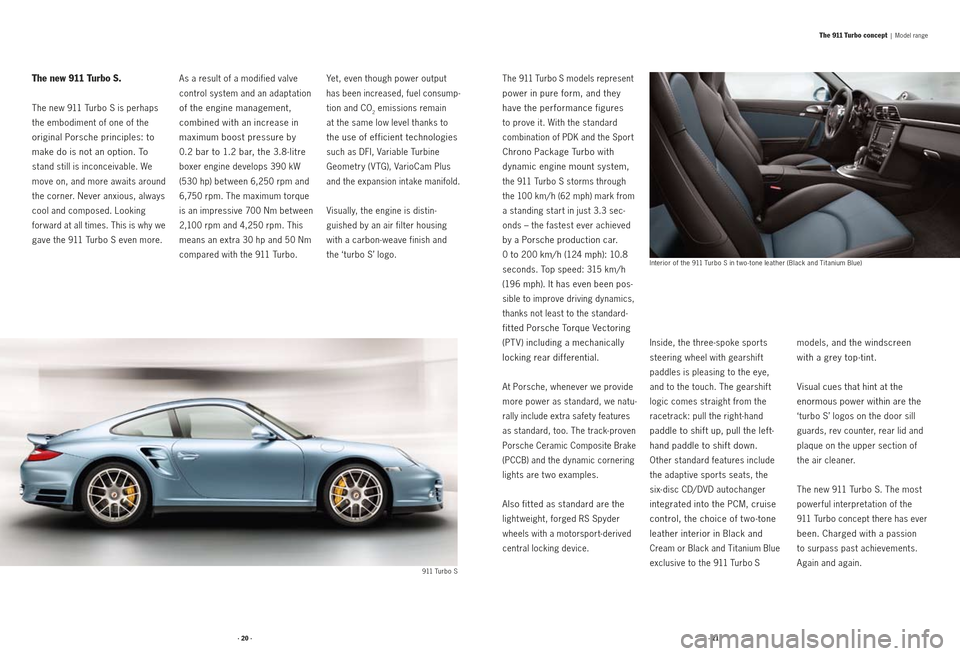
The new 911 Turbo S.
The new 911 Turbo S is perhaps
the embodiment of one of the
original Porsche principles: to
make do is not an option. To
stand still is inconceivable. We
move on, and more awaits around
the corner. Never anxious, always
cool and composed. Looking
forward at all times. This is why we
gave the 911 Turbo S even more. As a result of a modified valve
control system and an adaptation
of the engine management,
combined with an increase in
maximum boost pressure by
0.2 bar to 1.2 bar, the 3.8-litre
boxer engine develops 390 kW
(530 hp) bet ween 6,250 rpm and
6,750 rpm. The maximum torque
is an impressive 700 Nm bet ween
2,100 rpm and 4,250 rpm. This
means an extra 30 hp and 50 Nm
compared with the 911 Turbo. Yet, even though power output
has been increased, fuel consump
-
tion and CO2 emissions remain
at the same low level thanks to
the use of efficient technologies
such as DFI, Variable Turbine
Geometry (V TG), VarioCam Plus
and the expansion intake manifold.
Visually, the engine is distin -
guished by an air filter housing
with a carbon-weave finish and
the ‘turbo S’ logo.
The 911 Turbo S models represent
power in pure form, and they
have the performance figures
to prove it. With the standard
com bination of PDK and the Sport
Chrono Package Turbo with
dynamic engine mount system,
the 911 Turbo S storms through
the 100 km/ h (62 mph) mark from
a standing start in just 3.3 sec -
onds – the fastest ever achieved
by a Porsche production car.
0 to 200 km/ h (124 mph): 10.8
seconds. Top speed: 315 km/ h
(196 mph). It has even been pos -
sible to improve driving dynamics,
thanks not least to the standard-
fit ted Porsche Torque Vectoring
(PT V) including a mechanically
locking rear differential.
At Porsche, whenever we provide
more power as standard, we natu -
rally include extra safet y features
as standard, too. The track-proven
Porsche Ceramic Composite Brake
(PCCB) and the dynamic cornering
lights are t wo examples.
Also fit ted as standard are the
light weight, forged RS Spyder
wheels with a motorsport-derived
central locking device.
Inside, the three-spoke sports
steering wheel with gearshif t
paddles is pleasing to the eye,
and to the touch. The gearshif t
logic comes straight from the
racetrack: pull the right-hand
paddle to shift up, pull the left-
hand paddle to shift down.
Other standard features include
the adaptive sports seats, the
six- disc CD/ DVD autochanger
integrated into the PCM, cruise
control, the choice of t wo -tone
leather interior in Black and
Cream or Black and Titanium Blue
exclusive to the 911 Turbo S models,
and the windscreen
with a grey top-tint.
Visual cues that hint at the
enormous power within are the
‘ turbo S’ logos on the door sill
guards, rev counter, rear lid and
plaque on the upper section of
the air cleaner.
The new 911 Turbo S. The most
powerful interpretation of the
911 Turbo concept there has ever
been. Charged with a passion
to surpass past achievements.
Again and again.
The 911 Turbo concept | Model range
911 Turbo S Interior of the 911 Turbo S in t wo -tone leather (Black and Titanium Blue)
· 20 ·· 21 ·
Page 12 of 59
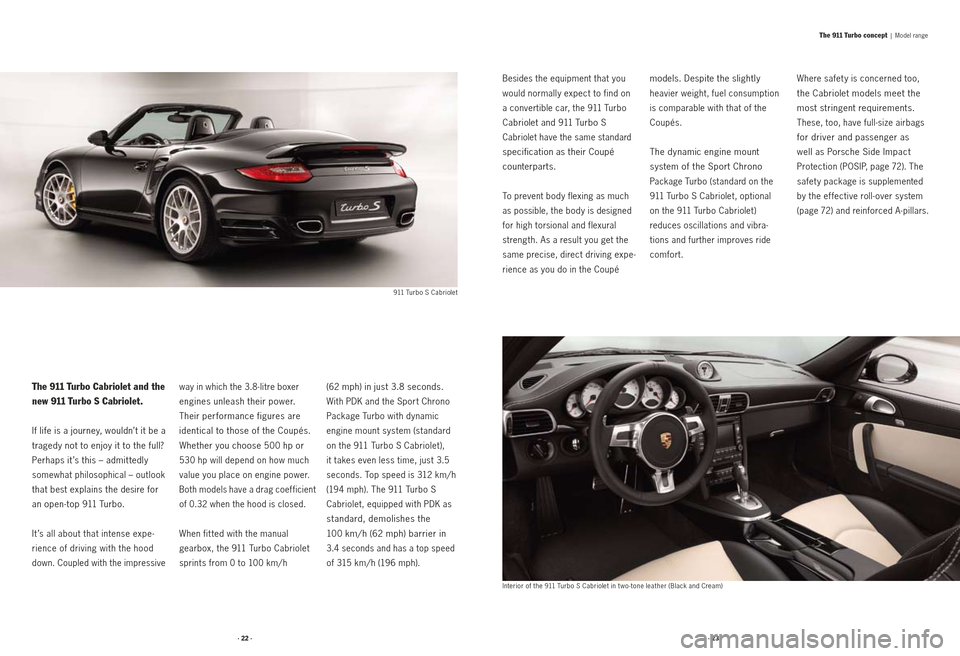
The 911 Turbo Cabriolet and the
new 911 Turbo S Cabriolet.
If life is a journey, wouldn’t it be a
tragedy not to enjoy it to the full?
Perhaps it ’s this – admit tedly
somewhat philosophical – outlook
that best explains the desire for
an open-top 911 Turbo.
It ’s all about that intense expe -
rience of driving with the hood
down. Coupled with the impressive
way in which the 3.8-litre boxer
engines unleash their power.
Their performance figures are
identical to those of the Coupés.
Whether you choose 500 hp or
530 hp will depend on how much
value you place on engine power.
Both models have a drag coefficient
of 0.32 when the hood is closed.
When fit ted with the manual
gearbox, the 911 Turbo Cabriolet
sprints from 0 to 100 km/ h
(62 mph) in just 3.8 seconds.
With PDK and the Sport Chrono
Package Turbo with dynamic
engine mount system (standard
on the 911 Turbo S Cabriolet),
it takes even less time, just 3.5
se conds. Top speed is 312 km/ h
(194 mph). The 911 Turbo S
Cabriolet, equipped with PDK as
standard, demolishes the
100 km/ h (62 mph) barrier in
3.4 seconds and has a top speed
of 315 km/ h (196 mph). Besides the equipment that you
would normally expect to find on
a convertible car, the 911 Turbo
Cabriolet and 911 Turbo S
Cabriolet have the same standard
specification as their Coupé
counterparts.
To prevent body flexing as much
as possible, the body is designed
for high torsional and flexural
strength. As a result you get the
same precise, direct driving expe -
rience as you do in the Coupé
The 911 Turbo concept | Model range
911 Turbo S Cabriolet
models. Despite the slightly
heavier weight, fuel consumption
is comparable with that of the
Coupés.
The dynamic engine mount
system of the Sport Chrono
Package Turbo (standard on the
911 Turbo S Cabriolet, optional
on the 911 Turbo Cabriolet)
reduces oscillations and vibra -
tions and further improves ride
comfort. Where safet y is concerned too,
the Cabriolet models meet the
most stringent requirements.
These, too, have full-size airbags
for driver and passenger as
well as Porsche Side Impact
Protection (POSIP, page 72). The
safet y package is supplemented
by the ef fective roll- over system
(page 72) and reinforced A-pillars.
Interior of the 911 Turbo S Cabriolet in t wo -tone leather (Black and Cream)
· 22 ·· 23 ·
Page 13 of 59
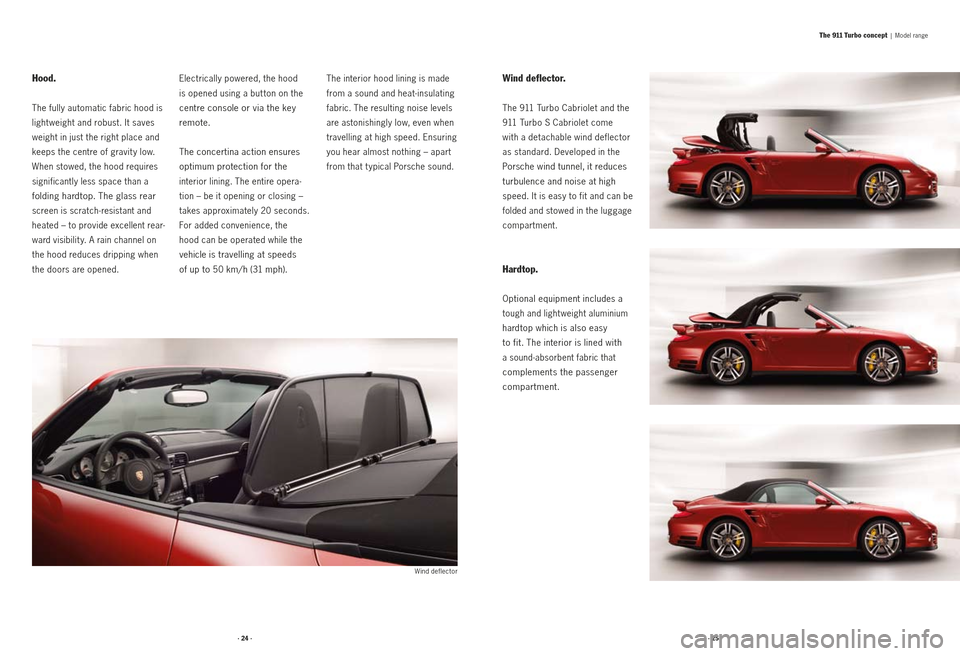
W ind deflector
Hood.
The fully automatic fabric hood is
light weight and robust. It saves
weight in just the right place and
keeps the centre of gravit y low.
When stowed, the hood requires
significantly less space than a
folding hardtop. The glass rear
screen is scratch-resistant and
heated – to provide excellent rear-
ward visibilit y. A rain channel on
the hood reduces dripping when
the doors are opened. Electrically powered, the hood
is opened using a but ton on the
centre console or via the key
remote.
The concertina action ensures
optimum protection for the
interior lining. The entire opera -
tion – be it opening or closing –
takes approximately 20 seconds.
For added convenience, the
hood can be operated while the
vehicle is travelling at speeds
of up to 50 km/ h (31 mph).
The interior hood lining is made
from a sound and heat-insulating
fabric. The resulting noise levels
are astonishingly low, even when
travelling at high speed. Ensuring
you hear almost nothing – apart
from that t ypical Porsche sound.
Wind deflector.
The 911 Turbo Cabriolet and the
911 Turbo S Cabriolet come
with a detachable wind deflector
as standard. Developed in the
Porsche wind tunnel, it reduces
turbulence and noise at high
speed. It is easy to fit and can be
folded and stowed in the luggage
compartment.
Hardtop.
Optional equipment includes a
tough and light weight aluminium
hardtop which is also easy
to fit. The interior is lined with
a sound-absorbent fabric that
complements the passenger
compartment.
The 911 Turbo concept | Model range
· 24 ·· 25 ·
Page 14 of 59
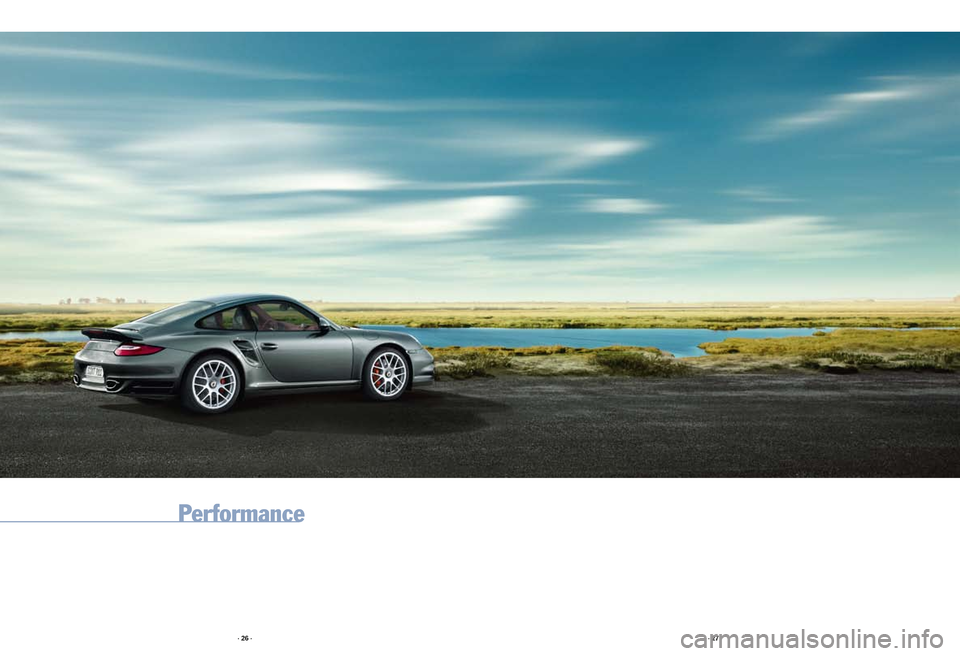
Performance
· 26 ·· 27 ·
Page 15 of 59
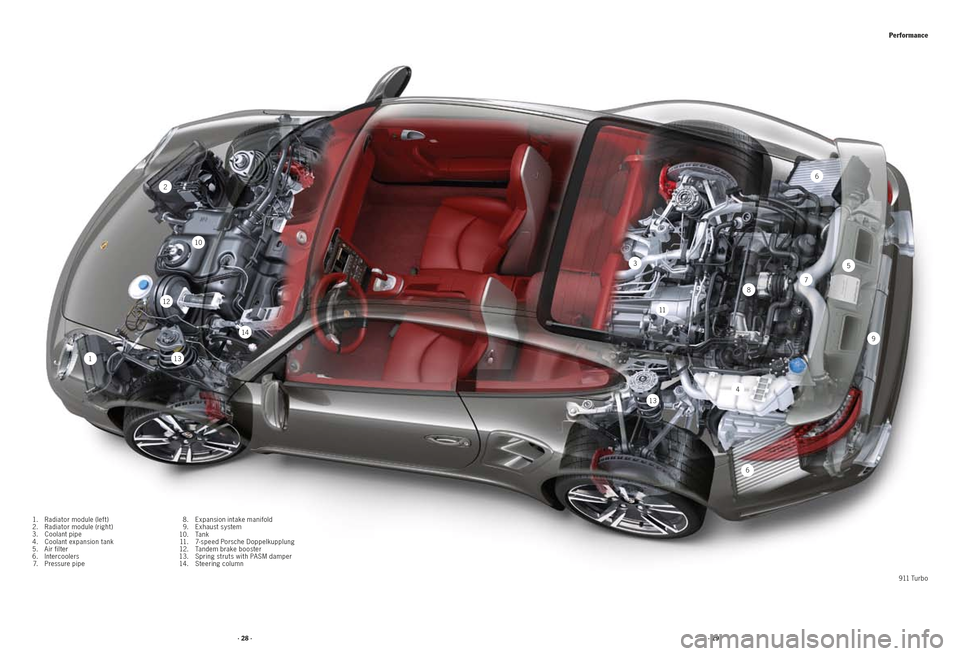
6
1
2
3
4
5
6
78
9
10
1112
13
13
14
8. Expansion intake manifold
9. Exhaust system
10. Ta n k
11. 7-speed Porsche Doppelkupplung
12. Tandem brake booster
13. Spring struts with PASM damper
14. Steering column
1. Radiator module (lef t)
2. Radiator module (right)
3. Coolant pipe
4. Coolant expansion tank
5. Air filter
6. Intercoolers
7. Pressure pipe
Performance
9 11 T u r b o
· 28 ·· 29 ·
Page 16 of 59
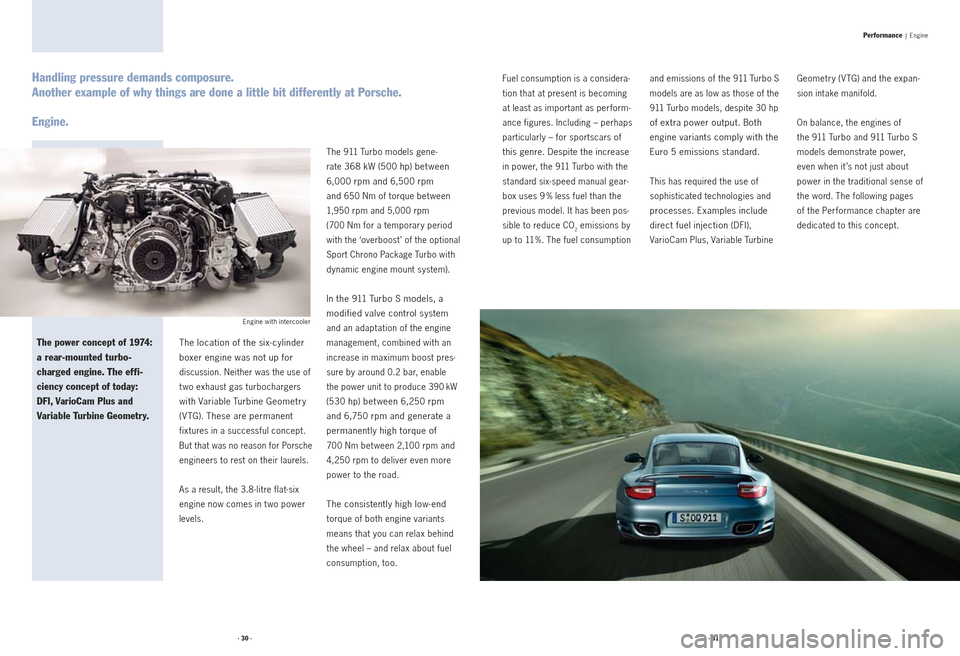
Engine with intercooler
The location of the six-cylinder
boxer engine was not up for
discussion. Neither was the use of
t wo exhaust gas turbochargers
with Variable Turbine Geometry
(V TG). These are permanent
fixtures in a successful concept.
But that was no reason for Porsche
engineers to rest on their laurels.
As a result, the 3.8-litre flat-six
engine now comes in t wo power
levels. The 911 Turbo models gene-
rate
368 kW (500 hp) bet ween
6,000 rpm and 6,500 rpm
and
650 Nm of torque bet ween
1,950 rpm and 5,000 rpm
(700 Nm for a temporary period
with the ‘overboost ’ of the optional
Sport Chrono Package Turbo w
ith
dynamic engine mount system).
In the 911 Turbo S models, a
modified valve control system
and an adaptation of the engine
management, combined with an
increase in maximum boost pres -
sure by around 0.2 bar, enable
the power unit to produce 390 kW
(530 hp) bet ween 6,250 rpm
and 6,750 rpm and generate a
permanently high torque of
700 Nm bet ween 2,100 rpm and
4,250 rpm to deliver even more
power to the road.
The consistently high low-end
torque of both engine variants
means that you can relax behind
the wheel – and relax about fuel
consumption, too.
The power concept of 1974:
a rear-mounted turbo -
charged engine. The effi -
ciency concept of today:
DFI, VarioCam Plus and
Variable Turbine Geometry.
Handling pressure demands composure.
Another example of why things are done a little bit differently at Porsche.
Engine.and emissions of the 911 Turbo S
models are as low as those of the
911 Turbo models, despite 30 hp
of extra power output. Both
engine variants comply with the
Euro 5 emissions standard.
This has required the use of
sophisticated technologies and
processes. Examples include
direct fuel injection (DFI),
VarioCam Plus, Variable Turbine
Fuel consumption is a considera
-
tion that at present is becoming
at least as important as perform -
ance figures. Including – perhaps
particularly – for sportscars of
this genre. Despite the increase
in power, the 911 Turbo with the
standard six-speed manual gear -
box uses 9 % less fuel than the
previous model. It has been pos -
sible to reduce CO
2 emissions by
up to 11 %. The fuel consumption Geometry (V TG) and the expan
-
sion intake manifold.
On balance, the engines of
the 911 Turbo and 911 Turbo S
models demonstrate power,
even when it ’s not just about
power in the traditional sense of
the word. The following pages
of the Performance chapter are
dedicated to this concept.
Performance | Engine
· 30 ·· 31 ·
Page 17 of 59
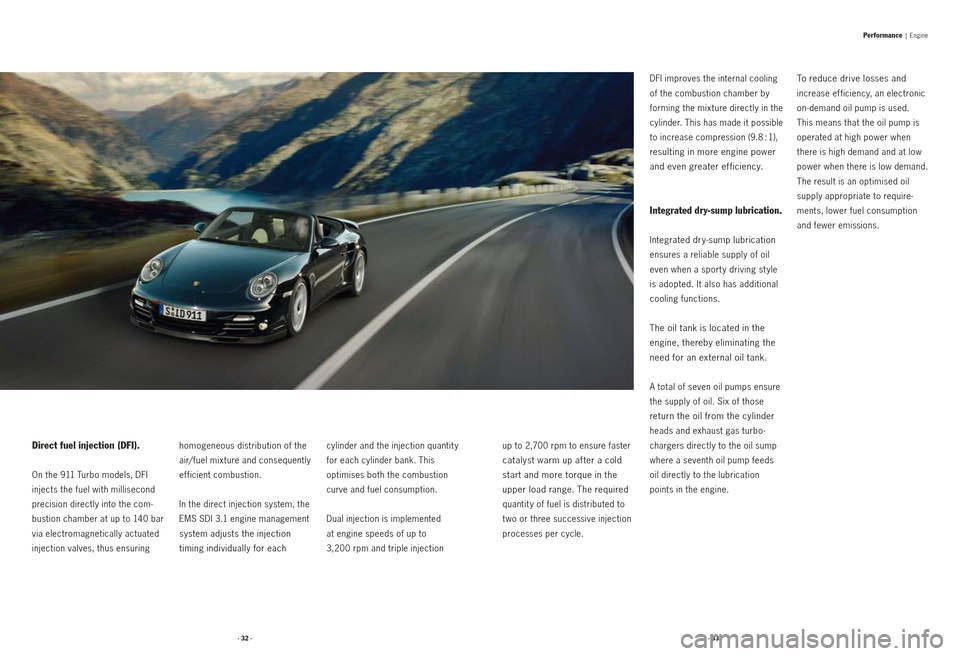
Direct fuel injection (DFI).
On the 911 Turbo models, DFI
injects the fuel with millisecond
precision directly into the com-
bustion chamber at up to 140 bar
via electromagnetically actuated
injection valves, thus ensuring homogeneous distribution of the
air/fuel mixture and consequently
ef ficient combustion.
In the direct injection system, the
EMS SDI 3.1 engine management
system adjusts the injection
timing individually for each
cylinder and the injection quantit y
for each cylinder bank. This
optimises both the combustion
curve and fuel consumption.
Dual injection is implemented
at engine speeds of up to
3,200 rpm and triple injection up to 2,700 rpm to ensure faster
catalyst warm up after a cold
start and more torque in the
upper load range. The required
quantit y of fuel is distributed to
t wo or three successive injection
processes per cycle. DFI improves the internal cooling
of the combustion chamber by
forming the mixture directly in the
cylinder. This has made it possible
to increase compression (9.8
: 1),
resulting in more engine power
and even greater efficiency.
Integrated dry-sump lubrication.
Integrated dr y-sump lubrication
ensures a reliable supply of oil
even when a sport y driving st yle
is adopted. It also has additional
cooling functions.
The oil tank is located in the
engine, thereby eliminating the
need for an external oil tank.
A total of seven oil pumps ensure
the supply of oil. Six of those
return the oil from the cylinder
heads and exhaust gas turbo -
chargers directly to the oil sump
where a seventh oil pump feeds
oil directly to the lubrication
points in the engine.
To reduce drive losses and
increase ef ficiency, an electronic
on - demand oil pump is used.
This means that the oil pump is
operated at high power when
there is high demand and at low
power when there is low demand.
The result is an optimised oil
supply appropriate to require -
ments, lower fuel consumption
and fewer emissions.
Performance | Engine
· 32 ·· 33 ·
Page 18 of 59
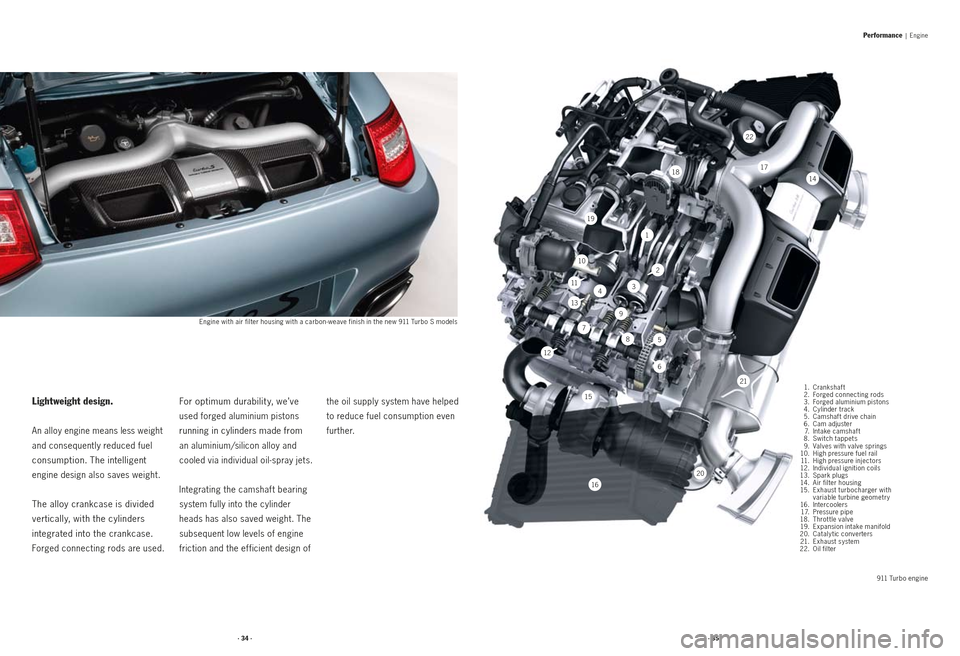
1
18
3
21
10
14
9
4
15
17
22
19
20
7
16
11
2
5
6
8
13
12 1. Crankshaft
2. Forged connecting rods
3. Forged aluminium pistons
4. Cylinder track
5. Camshaf t drive chain
6. Cam adjuster
7. Intake camshaf t
8. Switch tappets
9. Valves with valve springs
10. High pressure fuel rail
11. High pressure injectors
12. Individual ignition coils
13. Spark plugs
14. Air filter housing
15. Exhaust turbocharger with
variable turbine geometr y
16. Intercoolers
17. Pressure pipe
18. Throt tle valve
19. Expansion intake manifold
20. Cataly tic converters
21. Exhaust system
22. Oil filter
Lightweight design.
An alloy engine means less weight
and consequently reduced fuel
consumption. The intelligent
engine design also saves weight.
The alloy crankcase is divided
vertically, with the cylinders
integrated into the crankcase.
Forged connecting rods are used.
For optimum durabilit y, we’ve
used forged aluminium pistons
running in cylinders made from
an aluminium/silicon alloy and
cooled via individual oil-spray jets.
Integrating the camshaf t bearing
system fully into the cylinder
heads has also saved weight. The
subsequent low levels of engine
friction and the ef ficient design of the oil supply system have helped
to reduce fuel consumption even
further.
Performance
| Engine
Engine with air filter housing with a carbon -weave finish in the new 911 Turbo S models
911 Turbo engine
· 34 ·· 35 ·
Page 19 of 59
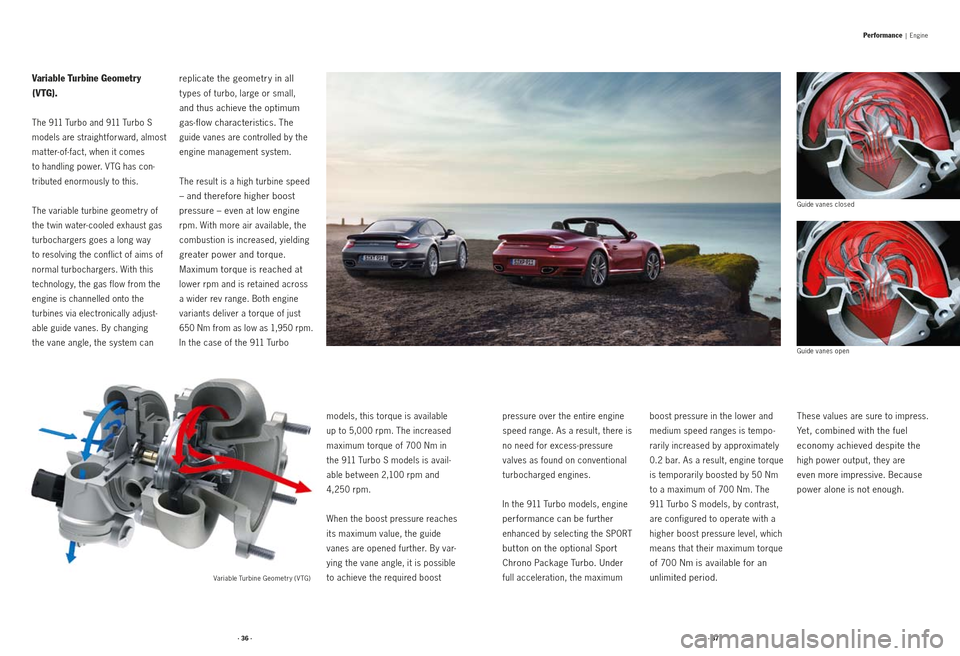
Variable Turbine Geometry
(V TG).
The 911 Turbo and 911 Turbo S
models are straightforward, almost
mat ter-of-fact, when it comes
to handling power. V TG has con -
tributed enormously to this.
The variable turbine geometry of
the t win water-cooled exhaust gas
turbochargers goes a long way
to resolving the conflict of aims of
normal turbochargers. With this
technology, the gas flow from the
engine is channelled onto the
turbines via electronically adjust -
able guide vanes. By changing
the vane angle, the system can
replicate the geometry in all
t ypes of turbo, large or small,
and thus achieve the optimum
gas-flow characteristics. The
guide vanes are controlled by the
engine management system.
The result is a high turbine speed
– and therefore higher boost
pressure – even at low engine
rpm. With more air available, the
combustion is increased, yielding
greater power and torque.
Maximum torque is reached at
lower rpm and is retained across
a wider rev range. Both engine
variants deliver a torque of just
650 Nm from as low as 1,950 rpm.
In the case of the 911 Turbo
models, this torque is available
up to 5,000 rpm. The increased
maximum torque of 700 Nm in
the 911 Turbo S models is avail -
able bet ween 2,100 rpm and
4,250 rpm.
When the boost pressure reaches
its maximum value, the guide
vanes are opened further. By var -
ying the vane angle, it is possible
to achieve the required boost pressure over the entire engine
speed range. As a result, there is
no need for excess-pressure
valves as found on conventional
turbocharged engines.
In the 911 Turbo models, engine
performance can be further
enhanced by selecting the SPORT
but ton on the optional Sport
Chrono Package Turbo. Under
full acceleration, the maximum boost pressure in the lower and
medium speed ranges is tempo
-
rarily increased by approximately
0.2 bar. As a result, engine torque
is temporarily boosted by 50 Nm
to a maximum of 700 Nm. The
911 Turbo S models, by contrast,
are configured to operate with a
higher boost pressure level, which
means that their maximum torque of 700 Nm is available for an
unlimited period.
These values are sure to impress.
Yet, combined with the fuel
economy achieved despite the
high power output, they are
even more impressive. Because
power alone is not enough.
Guide vanes closed
Guide vanes open
Performance | Engine
Variable Turbine Geometry (VTG)
· 36 ·· 37 ·
Page 20 of 59
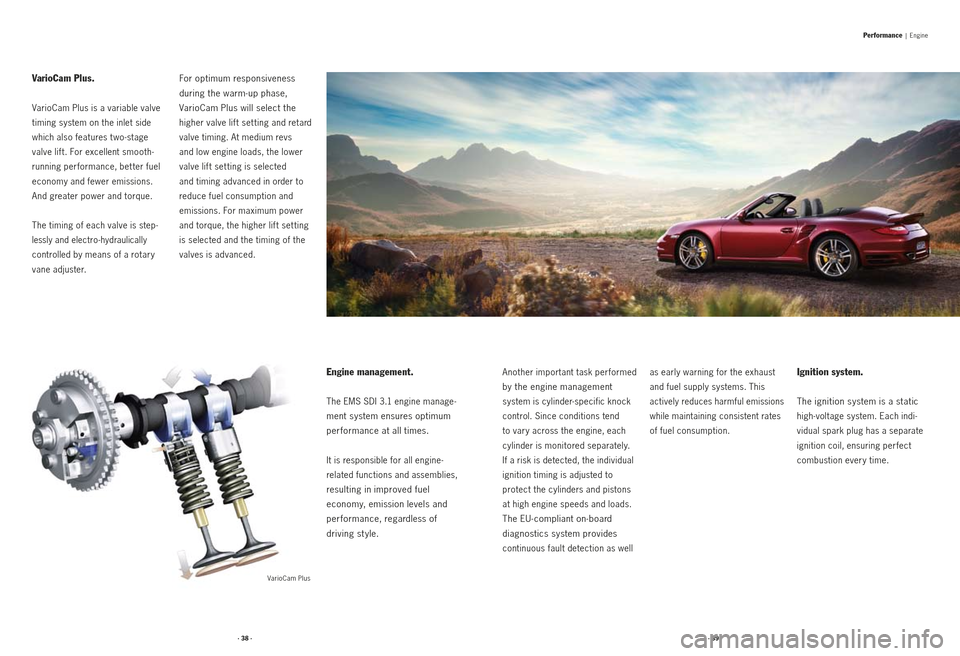
VarioCam Plus.
VarioCam Plus is a variable valve
timing system on the inlet side
which also features t wo -stage
valve lift. For excellent smooth-
running performance, bet ter fuel
economy and fewer emissions.
And greater power and torque.
The timing of each valve is step-
lessly and electro -hydraulically
controlled by means of a rotary
vane adjuster.
For optimum responsiveness
during the warm-up phase,
VarioCam Plus will select the
higher valve lif t set ting and retard
valve timing. At medium revs
and low engine loads, the lower
valve lif t set ting is selected
and timing advanced in order to
reduce fuel consumption and
emissions. For maximum power
and torque, the higher lif t set ting
is selected and the timing of the
valves is advanced.
Engine management.
The EMS SDI 3.1 engine manage -
ment system ensures optimum
performance at all times.
It is responsible for all engine-
related functions and assemblies,
resulting in improved fuel
economy, emission levels and
performance, regardless of
driving st yle.
Another important task performed
by the engine management
system is cylinder-specific knock
control. Since conditions tend
to vary across the engine, each
cylinder is monitored separately.
If a risk is detected, the individual
ignition timing is adjusted to
protect the cylinders and pistons
at high engine speeds and loads.
The EU-compliant on-board
diagnostics system provides
continuous fault detection as well as early warning for the exhaust
and fuel supply systems. This
actively reduces harmful emissions
while maintaining consistent rates
of fuel consumption.
Ignition system.
The ignition system is a static
high-voltage system. Each indi -
vidual spark plug has a separate
ignition coil, ensuring perfect
combustion every time.
Performance | Engine
VarioCam Plus
· 38 ·· 39 ·